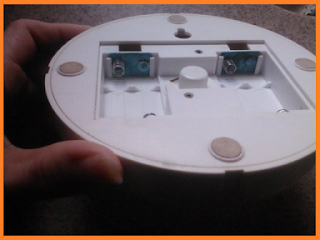"Eeeew! It's green. That's just not right..."
I mentioned my corroded car battery a while back, but didn't talk about how to actually clean that corrosion from batteries. Naturally, I didn't realize this until way after that post was written. Let's see if I can make up for that, shall we?
I found an emergency light that had been packed away since moving up to Minnesota. It sat in a box, unused. This wouldn't have been a problem, except that in the blur of packing, I had neglected to do one simple thing:
Remove the batteries.
Oops.
Naturally, sitting in a humid basement for an extended period caused corrosion to occur... on a rather large scale.
Ugh.
The good news, though, is that removing corrosion is a simple fix, even when the corrosion is this extensive. All you need are three things:
- Baking soda
- water
- a firmly bristled brush
Simply add enough water to the baking soda that it is turned into a paste, and lightly brush it into the corroded areas of the battery compartment. Easy-peasy! Be careful not to add too much water, of course - water and electronics don't really get along all that well, of course.
Once the corrosion has been cleared away, allow the battery compartment to sit for a while, just to be sure there's no residual moisture hiding in corners.
The whole process doesn't take very long, at all. After only 5 minutes, my emergency light's battery compartment looked like this:
You can still see corrosion here, but there's a significant difference. Why doesn't this look perfect?
Well, the best brush to use, of course, is a toothbrush. It's small and can get to areas that most other brushes can't. Unfortunately, we didn't have any old toothbrushes available, and I wasn't about to use my current one, so I was stuck with a brush that's used to clean plastic straws. The tip, therefore, was metal, rather than bristled, so I couldn't get the perfect reach needed within the corners and curves.
But if I can do this well using a poor brush choice, imagine what you can do with the proper materials!
Even though this was all I had to work with, I was able to clear away enough corrosion to get the light working, again, and that's the ultimate goal.
Plus... once you're finished, you can use the remaining baking soda to scour any pans or counters that need it, making baking soda a great natural cleaner, as well.
Score!!!
Now, go clean that corrosion from whatever battery compartment needs some extra love. This is much more cost effective and eco-friendly than going out and buying a whole new light, after all!






No comments:
Post a Comment